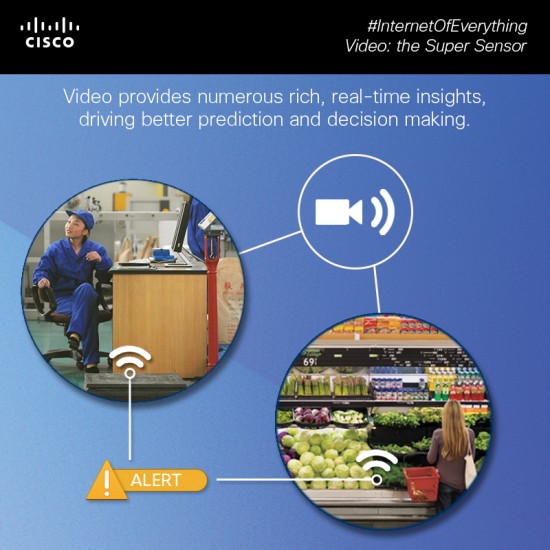A key advantage of the Internet of Everything (IoE) is the ability to “see” the world around us in unprecedented ways.
One way to do this is through the millions of cheap, tiny digital sensors generating data from shoes, tires, shopping carts, jet-engine parts, medical equipment, and just about anything else you can imagine.
But another type of sensor promises even deeper visibility and insight: video. Connected video — when deployed in the right situations and combined with other IoE components, such as analytics and mobility — can truly transform the ways in which we sense the world. And for organizations, video will provide rich, real-time insights that will drive hyper-aware decision-making and predictive strategies.

I call video the IoE Super Sensor, because of its ubiquitous versatility:
- Video cameras are nearly pervasive already. And they can be deployed in many more places with little disturbance to the environment — and away from potentially damaging forces such as vibrations, temperature spikes, and human interaction. Solar, heat, motion, and other IoE energy sources promise even greater versatility, offering the ability to mount cameras “off the grid.”
- Video can also monitor vast areas from a distance, and this capability will only improve as 4K video rolls out, giving a single camera the power and sweep of four HD cameras.
- Video analytics can be updated easily and almost limitlessly. Changes in software or firmware can add new capabilities to dramatically extend camera ROI and lifespan. A video infrastructure designed for security, for example, could also be used to measure shopper demographics or product availability, with no change in hardware or infrastructure.
- Breakthroughs in computer vision are driving startling new capabilities. For example, Facebook recently developed software almost as good at matching faces as humans, and age and mood determination are improving steadily. Another advance is video’s ability to identify individuals through gait and posture. This can be applied in environments that would challenge humans, such as within crowds or during periods of low lighting.
As new technologies unlock expanded realms of possibility, video capabilities will continue to increase. Here are some additional innovations that are either newly available or on the immediate horizon:
- Infinite-focus cameras, such as the Lytro, capture a wealth of visual information that can be analyzed in almost endless ways, providing new value even long after it is captured.
- Eulerian Video Magnification can detect pulse and subtle movement. It can monitor, for example, a baby’s breathing and vital signs on a level that is invisible to the human eye.
- Additional new technologies will enable cameras to “see” around corners by deciphering the reflections on walls. Video analytics is also even able to perceive images through frosted glass or other translucent materials!
- Through miniaturization and lens-free technologies, video will become an integral component of an avalanche of new devices, many of which will be smaller, lighter, and wearable. Furthermore, ever faster and smaller processors will allow placement of analytics capabilities within more devices themselves, lessening the need for central video processing.
I believe that the pace of video innovation will continue to accelerate. And the potential for video to transform organizations and industries will increase as well.
Here are few considerations for CxOs:
- Technology leaders should evaluate multiple architecture options for connected video. Fog computing, onboard analytics embedded in devices, and central video data processing can combine for versatile and flexible processing and storage.
- When bringing together different IoE elements — such as Wi-Fi, mechanical sensors, and video — the whole is greater than the sum of its parts. I wrote about sensor fusion in a previous blog, and it has great potential for enhancing the power of video.
- Crowdsourcing can provide exciting new sources of video insight from employees, customers, and partners. One example might be from shoppers’ mobile devices, which could share images of out-of-stock store shelves.
- Forefront platforms for video, including robots, drones, and wearables, offer new perspectives and vantage points for gaining key insights.
I believe that all of these connected-video innovations have enormous economic potential, along with the ability to transform organizations in exciting ways. Business leaders will need to ensure that their organizations are video-ready, and well prepared for this key element of the IoE revolution.
What do you think about connected video and its implications for your industry or organization? Join the conversation on Twitter using #InternetofEverything and let us know your thoughts.
CONNECT WITH US